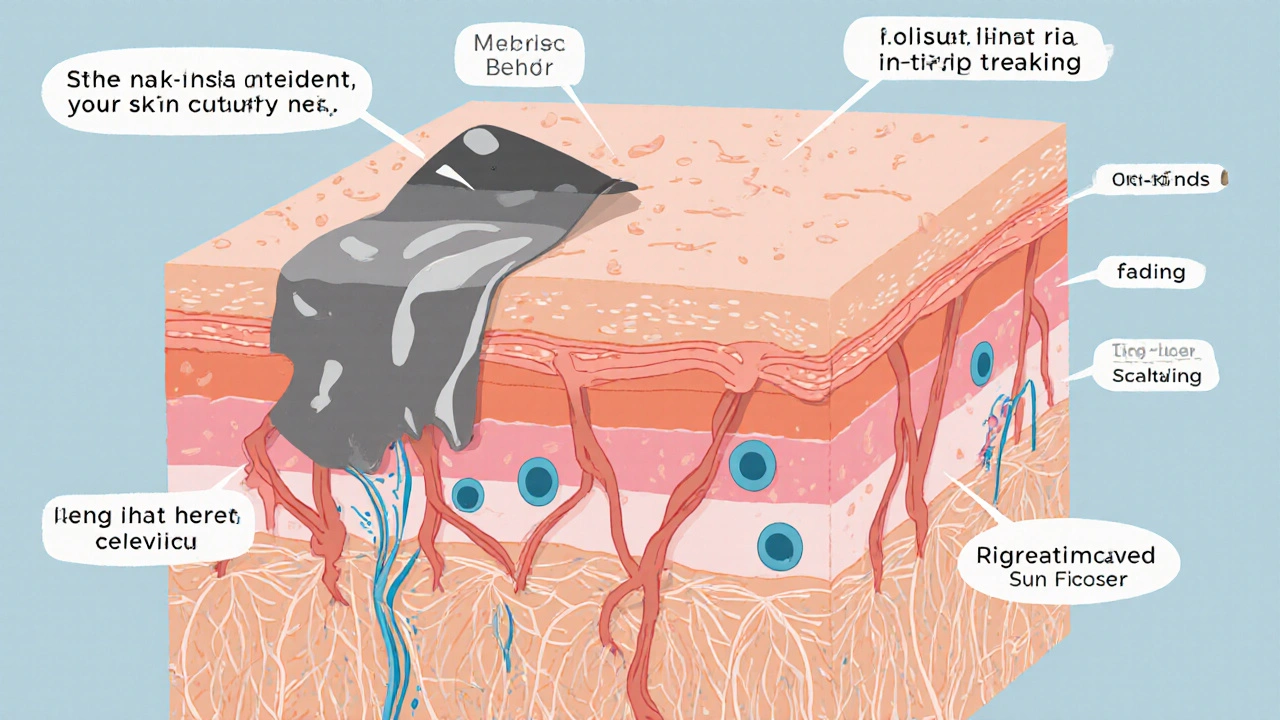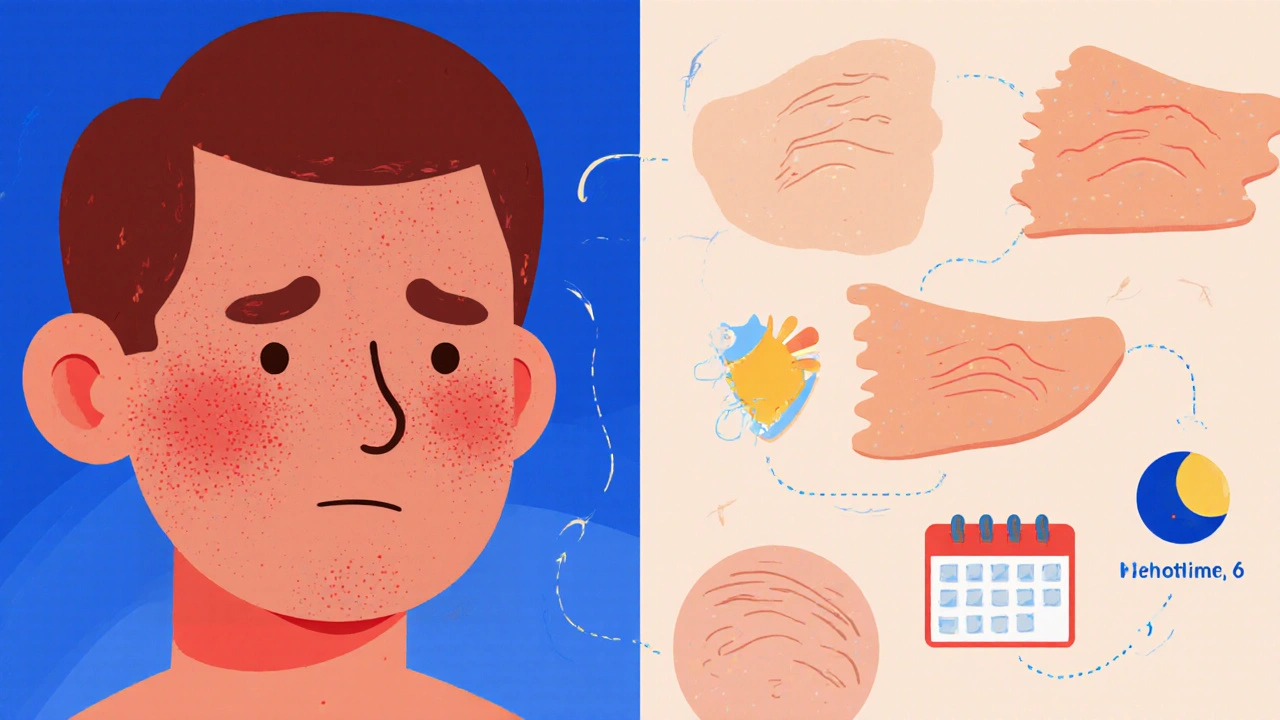A-Ret Gel is a topical treatment used for acne, fine lines, and sun-damaged skin. It contains tretinoin, a form of vitamin A that speeds up skin cell turnover. Unlike regular moisturizers, this isn’t just about hydration-it’s about reshaping your skin from the inside out. Many people start using it hoping for clear skin, only to end up with redness, peeling, or frustration. That’s not because it doesn’t work. It’s because most don’t know how to use it right.
What’s Actually in A-Ret Gel?
A-Ret Gel isn’t a brand name you’ll find on pharmacy shelves in the UK. It’s a generic version of tretinoin, the same active ingredient in Retin-A. Tretinoin has been used since the 1970s, and it’s one of the few skincare ingredients backed by decades of clinical research. The concentration usually ranges from 0.025% to 0.1%. Higher isn’t always better. Most people start with 0.025% or 0.05% to avoid irritation.
What makes it different from over-the-counter retinol? Tretinoin is a prescription-strength retinoid. Your skin converts retinol into retinoic acid slowly. Tretinoin is already retinoic acid. That means it works faster and stronger. A 0.05% tretinoin gel works about three times as fast as a 1% retinol cream. That’s why dermatologists prescribe it for stubborn acne and visible aging.
How A-Ret Gel Changes Your Skin
When you apply A-Ret Gel, you’re not just treating surface problems-you’re triggering a cellular reset. Here’s what happens:
- Dead skin cells shed faster, unclogging pores and reducing blackheads
- Collagen production increases, smoothing out fine lines over time
- Oil production slows down, which helps prevent new breakouts
- Pigmentation from sun damage fades as older, damaged cells are replaced
Studies show that after 12 weeks of consistent use, users see a 40-60% reduction in acne lesions. After six months, wrinkles around the eyes and mouth improve by up to 30%. But these results don’t show up overnight. Most people notice changes between weeks 6 and 12. If you stop after two weeks because your skin is flaky, you’ll never see the payoff.
Who Should Use A-Ret Gel?
It’s not for everyone. You should consider A-Ret Gel if:
- You have persistent acne that won’t clear with benzoyl peroxide or salicylic acid
- You’re in your late 20s or older and noticing early signs of aging-fine lines, uneven tone, rough texture
- You’ve tried other treatments and want something more effective
It’s not recommended if you:
- Are pregnant or breastfeeding (tretinoin can cross the placenta)
- Have eczema, rosacea, or severely sensitive skin
- Use other strong exfoliants like glycolic acid or physical scrubs daily
People with darker skin tones can use it safely, but they need to be extra careful about irritation. Post-inflammatory hyperpigmentation (dark spots after breakouts) can get worse if the skin gets too inflamed. Start slow, use sunscreen, and don’t layer it with other actives.
How to Use A-Ret Gel Without Irritating Your Skin
The biggest mistake people make? Applying too much, too often.
Here’s the real-world routine that works:
- Wash your face with a gentle cleanser. Pat dry-don’t rub.
- Wait 20 minutes. Let your skin fully dry. Applying it to damp skin increases irritation.
- Squeeze out a pea-sized amount for your entire face. That’s all you need.
- Spread it thinly over your forehead, cheeks, nose, and chin. Avoid the corners of your eyes and lips.
- Wait 10 minutes, then apply a fragrance-free moisturizer.
- Use it every other night for the first two weeks. If your skin tolerates it, move to nightly.
Don’t use it during the day. Sun exposure breaks down tretinoin and makes your skin more sensitive. Always wear SPF 30 or higher, even on cloudy days. UV damage reverses the progress you’re making.

What to Expect in the First Few Weeks
Week 1-2: Dryness, flaking, redness. This is called the “retinization” phase. It’s normal. It doesn’t mean it’s not working-it means your skin is adjusting.
Week 3-6: Breakouts might get worse before they get better. This is purging, not a reaction. Purging happens when clogged pores are cleared out faster than usual. It usually lasts 4-6 weeks.
Week 8+: Skin feels smoother. Pores look smaller. Acne is less frequent. Dark spots begin to fade.
If you’re still burning, stinging, or peeling after 8 weeks, you’re using too much or too often. Cut back to once a week until your skin recovers, then slowly rebuild.
What Doesn’t Work With A-Ret Gel
Combining it with the wrong products is a recipe for disaster. Avoid these:
- Physical scrubs or exfoliating brushes-they tear already sensitive skin
- High-strength AHAs or BHAs (like 10% glycolic acid or 2% salicylic acid) on the same night
- Alcohol-based toners-they strip your skin’s barrier
- Other retinoids (like adapalene or tazarotene)-stacking them increases risk without added benefit
Instead, pair it with:
- A ceramide-based moisturizer (helps repair the skin barrier)
- A simple vitamin C serum in the morning (boosts collagen and protects from sun damage)
- Hydrocolloid patches for active breakouts
Where to Get A-Ret Gel in the UK
You can’t buy A-Ret Gel over the counter. It’s a prescription-only medication. You’ll need to see a GP or dermatologist. Some online clinics offer telehealth consultations-just make sure they’re registered with the GMC. Never buy it from unregulated websites. Counterfeit products are common, and some contain steroids or unknown chemicals that can damage your skin permanently.
Cost varies. A 30g tube typically costs between £20-£40 if prescribed through the NHS. Private clinics charge more, around £50-£80. The price doesn’t change much between brands because they all contain the same active ingredient.

How Long Should You Use It?
Unlike creams you use until your skin clears, tretinoin is a long-term treatment. Most people use it for years. Stopping means your skin will slowly return to its old state. Acne may come back. Fine lines will reappear. Sun spots will darken again.
Think of it like brushing your teeth. You don’t stop after a cavity is filled. You keep doing it to prevent future problems. A-Ret Gel is the same. Consistency matters more than intensity.
When to See a Dermatologist
Call your doctor if:
- Your skin becomes severely red, swollen, or blistered
- You develop intense itching or pain
- Dark spots get darker instead of fading
- You’re not seeing any improvement after 4 months
Some people need a different strength or formulation. Others may need to combine it with antibiotics or light therapy. Don’t guess-get professional advice.
Can A-Ret Gel be used for wrinkles only, without acne?
Yes. Tretinoin is one of the most proven anti-aging treatments available. It’s FDA-approved for both acne and photoaging. Even if you don’t have breakouts, it helps reduce fine lines, improve skin texture, and fade sun spots. Many people in their 30s and 40s use it purely for anti-aging benefits.
Does A-Ret Gel make your skin more sensitive to the sun?
Absolutely. Tretinoin increases your skin’s sensitivity to UV rays. Without sunscreen, you risk sunburn, long-term damage, and even worsening pigmentation. Always use SPF 30+ daily, even in winter or when it’s cloudy. Reapply every two hours if you’re outside for long periods.
How long does a tube of A-Ret Gel last?
A 30g tube lasts about 3-4 months if you use a pea-sized amount every night. If you use it every other night, it can last 6-8 months. Using more than recommended doesn’t speed up results-it just wastes product and increases irritation.
Can I use A-Ret Gel if I have oily skin?
Yes. In fact, oily skin often responds very well. Tretinoin reduces sebum production over time. Many users notice their skin becomes less shiny after 2-3 months. Avoid heavy moisturizers-opt for lightweight, non-comedogenic formulas instead.
Is A-Ret Gel the same as Retin-A?
Yes, essentially. Retin-A is the original brand name for tretinoin. A-Ret Gel is a generic version with the same active ingredient, strength, and effectiveness. The only differences are the inactive ingredients and price. Generics like A-Ret Gel are just as safe and effective.
Final Thoughts
A-Ret Gel isn’t a miracle. But it’s one of the few skincare products with real, measurable, long-term results. It doesn’t promise instant glow-ups. It promises gradual, lasting change-if you stick with it. The first few weeks are tough. The first few months are slow. But after six months? You’ll look in the mirror and wonder why you didn’t start sooner.
